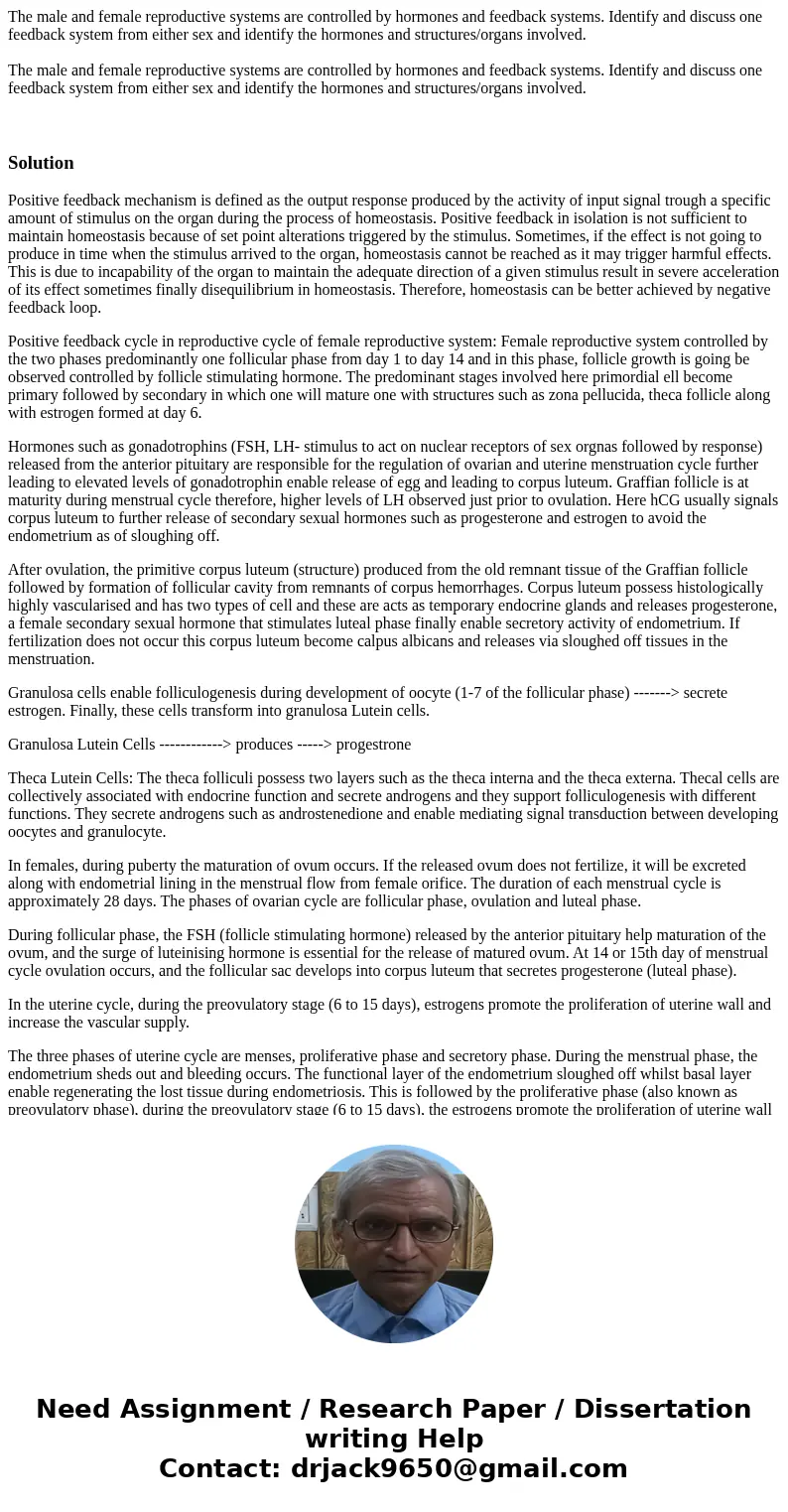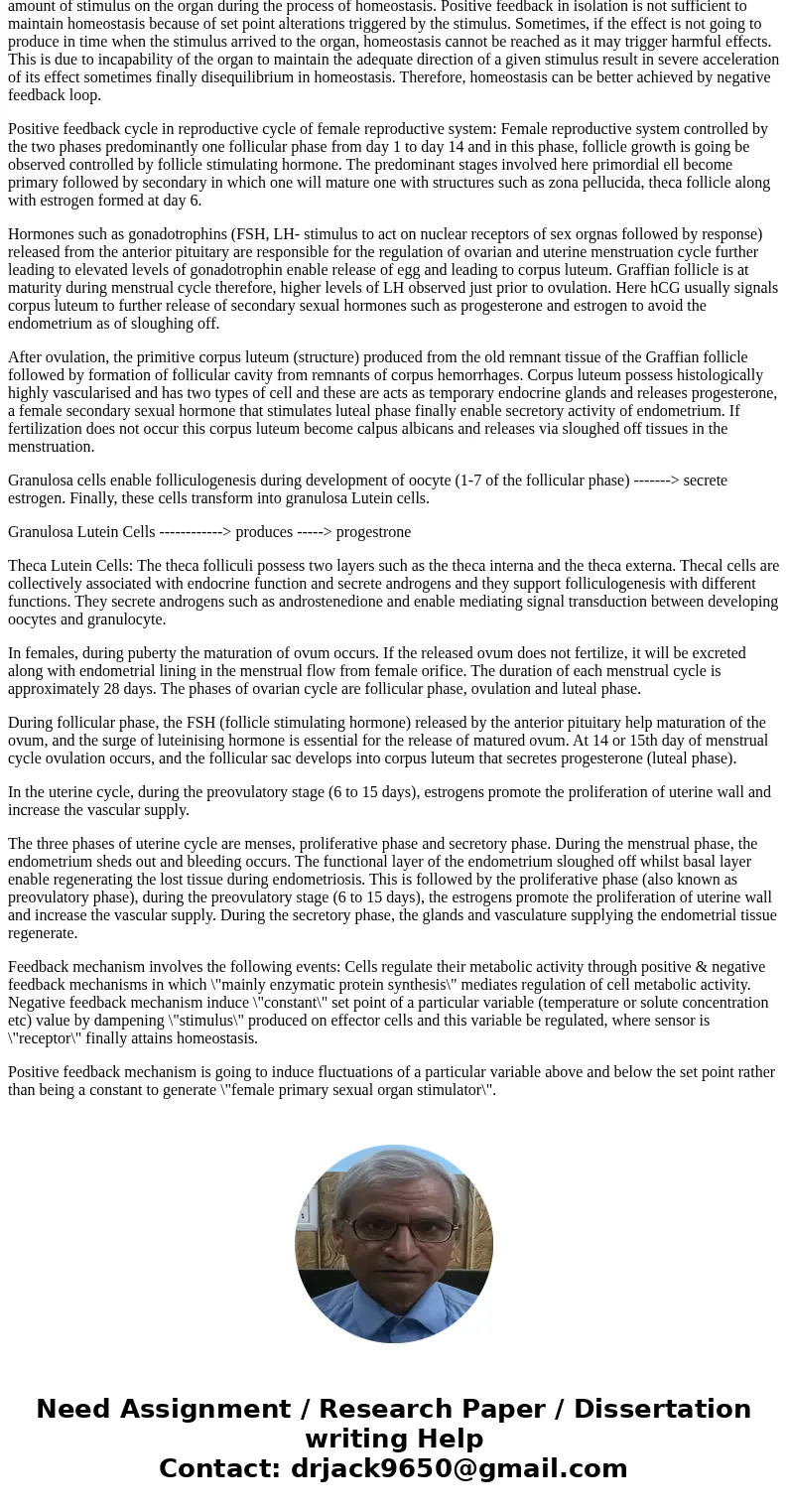The male and female reproductive systems are controlled by h
Solution
Positive feedback mechanism is defined as the output response produced by the activity of input signal trough a specific amount of stimulus on the organ during the process of homeostasis. Positive feedback in isolation is not sufficient to maintain homeostasis because of set point alterations triggered by the stimulus. Sometimes, if the effect is not going to produce in time when the stimulus arrived to the organ, homeostasis cannot be reached as it may trigger harmful effects. This is due to incapability of the organ to maintain the adequate direction of a given stimulus result in severe acceleration of its effect sometimes finally disequilibrium in homeostasis. Therefore, homeostasis can be better achieved by negative feedback loop.
Positive feedback cycle in reproductive cycle of female reproductive system: Female reproductive system controlled by the two phases predominantly one follicular phase from day 1 to day 14 and in this phase, follicle growth is going be observed controlled by follicle stimulating hormone. The predominant stages involved here primordial ell become primary followed by secondary in which one will mature one with structures such as zona pellucida, theca follicle along with estrogen formed at day 6.
Hormones such as gonadotrophins (FSH, LH- stimulus to act on nuclear receptors of sex orgnas followed by response) released from the anterior pituitary are responsible for the regulation of ovarian and uterine menstruation cycle further leading to elevated levels of gonadotrophin enable release of egg and leading to corpus luteum. Graffian follicle is at maturity during menstrual cycle therefore, higher levels of LH observed just prior to ovulation. Here hCG usually signals corpus luteum to further release of secondary sexual hormones such as progesterone and estrogen to avoid the endometrium as of sloughing off.
After ovulation, the primitive corpus luteum (structure) produced from the old remnant tissue of the Graffian follicle followed by formation of follicular cavity from remnants of corpus hemorrhages. Corpus luteum possess histologically highly vascularised and has two types of cell and these are acts as temporary endocrine glands and releases progesterone, a female secondary sexual hormone that stimulates luteal phase finally enable secretory activity of endometrium. If fertilization does not occur this corpus luteum become calpus albicans and releases via sloughed off tissues in the menstruation.
Granulosa cells enable folliculogenesis during development of oocyte (1-7 of the follicular phase) -------> secrete estrogen. Finally, these cells transform into granulosa Lutein cells.
Granulosa Lutein Cells ------------> produces -----> progestrone
Theca Lutein Cells: The theca folliculi possess two layers such as the theca interna and the theca externa. Thecal cells are collectively associated with endocrine function and secrete androgens and they support folliculogenesis with different functions. They secrete androgens such as androstenedione and enable mediating signal transduction between developing oocytes and granulocyte.
In females, during puberty the maturation of ovum occurs. If the released ovum does not fertilize, it will be excreted along with endometrial lining in the menstrual flow from female orifice. The duration of each menstrual cycle is approximately 28 days. The phases of ovarian cycle are follicular phase, ovulation and luteal phase.
During follicular phase, the FSH (follicle stimulating hormone) released by the anterior pituitary help maturation of the ovum, and the surge of luteinising hormone is essential for the release of matured ovum. At 14 or 15th day of menstrual cycle ovulation occurs, and the follicular sac develops into corpus luteum that secretes progesterone (luteal phase).
In the uterine cycle, during the preovulatory stage (6 to 15 days), estrogens promote the proliferation of uterine wall and increase the vascular supply.
The three phases of uterine cycle are menses, proliferative phase and secretory phase. During the menstrual phase, the endometrium sheds out and bleeding occurs. The functional layer of the endometrium sloughed off whilst basal layer enable regenerating the lost tissue during endometriosis. This is followed by the proliferative phase (also known as preovulatory phase), during the preovulatory stage (6 to 15 days), the estrogens promote the proliferation of uterine wall and increase the vascular supply. During the secretory phase, the glands and vasculature supplying the endometrial tissue regenerate.
Feedback mechanism involves the following events: Cells regulate their metabolic activity through positive & negative feedback mechanisms in which \"mainly enzymatic protein synthesis\" mediates regulation of cell metabolic activity. Negative feedback mechanism induce \"constant\" set point of a particular variable (temperature or solute concentration etc) value by dampening \"stimulus\" produced on effector cells and this variable be regulated, where sensor is \"receptor\" finally attains homeostasis.
Positive feedback mechanism is going to induce fluctuations of a particular variable above and below the set point rather than being a constant to generate \"female primary sexual organ stimulator\".


 Homework Sourse
Homework Sourse